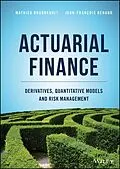A new textbook offering a comprehensive introduction to models and techniques for the emerging field of actuarial Finance
Drs. Boudreault and Renaud answer the need for a clear, application-oriented guide to the growing field of actuarial finance with this volume, which focuses on the mathematical models and techniques used in actuarial finance for the pricing and hedging of actuarial liabilities exposed to financial markets and other contingencies. With roots in modern financial mathematics, actuarial finance presents unique challenges due to the long-term nature of insurance liabilities, the presence of mortality or other contingencies and the structure and regulations of the insurance and pension markets.
Motivated, designed and written for and by actuaries, this book puts actuarial applications at the forefront in addition to balancing mathematics and finance at an adequate level to actuarial undergraduates. While the classical theory of financial mathematics is discussed, the authors provide a thorough grounding in such crucial topics as recognizing embedded options in actuarial liabilities, adequately quantifying and pricing liabilities, and using derivatives and other assets to manage actuarial and financial risks.
Actuarial applications are emphasized and illustrated with about 300 examples and 200 exercises. The book also comprises end-of-chapter point-form summaries to help the reader review the most important concepts. Additional topics and features include:
* Compares pricing in insurance and financial markets
* Discusses event-triggered derivatives such as weather, catastrophe and longevity derivatives and how they can be used for risk management;
* Introduces equity-linked insurance and annuities (EIAs, VAs), relates them to common derivatives and how to manage mortality for these products
* Introduces pricing and replication in incomplete markets and analyze the impact of market incompleteness on insurance and risk management;
* Presents immunization techniques alongside Greeks-based hedging;
* Covers in detail how to delta-gamma/rho/vega hedge a liability and how to rebalance periodically a hedging portfolio.
This text will prove itself a firm foundation for undergraduate courses in financial mathematics or economics, actuarial mathematics or derivative markets. It is also highly applicable to current and future actuaries preparing for the exams or actuary professionals looking for a valuable addition to their reference shelf.
As of 2019, the book covers significant parts of the Society of Actuaries' Exams FM, IFM and QFI Core, and the Casualty Actuarial Society's Exams 2 and 3F. It is assumed the reader has basic skills in calculus (differentiation and integration of functions), probability (at the level of the Society of Actuaries' Exam P), interest theory (time value of money) and, ideally, a basic understanding of elementary stochastic processes such as random walks.
Autorentext
MATHIEU BOUDREAULT, PHD, is Professor of Actuarial Science in the Département de mathématiques at Université du Québec à Montréal (UQAM), Canada. Fellow of the Society of Actuaries and Associate of the Canadian Institute of Actuaries, his teaching and research interests include actuarial finance, catastrophe modeling and credit risk.
JEAN-FRANÇOIS RENAUD, PHD, is Professor of Actuarial Science in the Département de mathématiques at Université du Québec à Montréal (UQAM), Canada. His teaching and research interests include actuarial finance, actuarial mathematics and applied probability.
Inhalt
Acknowledgments xvii
Preface xix
Part I Introduction to actuarial finance 1
1 Actuaries and their environment 3
1.1 Key concepts 3
1.2 Insurance and financial markets 6
1.3 Actuarial and financial risks 8
1.4 Diversifiable and systematic risks 9
1.5 Risk management approaches 15
1.6 Summary 16
1.7 Exercises 17
2 Financial markets and their securities 21
2.1 Bonds and interest rates 21
2.2 Stocks 29
2.3 Derivatives 32
2.4 Structure of financial markets 35
2.5 Mispricing and arbitrage opportunities 38
2.6 Summary 42
2.7 Exercises 44
3 Forwards and futures 49
3.1 Framework 49
3.2 Equity forwards 52
3.3 Currency forwards 59
3.4 Commodity forwards 61
3.5 Futures contracts 62
3.6 Summary 70
3.7 Exercises 72
4 Swaps 75
4.1 Framework 76
4.2 Interest rate swaps 77
4.3 Currency swaps 87
4.4 Credit default swaps 90
4.5 Commodity swaps 93
4.6 Summary 95
4.7 Exercises 96
5 Options 99
5.1 Framework 100
5.2 Basic options 102
5.3 Main uses of options 107
5.4 Investment strategies with basic options 110
5.5 Summary 114
5.6 Exercises 116
6 Engineering basic options 119
6.1 Simple mathematical functions for financial engineering 119
6.2 Parity relationships 122
6.3 Additional payoff design with calls and puts 126
6.4 More on the put-call parity 129
6.5 American options 133
6.6 Summary 136
6.7 Exercises 137
7 Engineering advanced derivatives 141
7.1 Exotic options 141
7.2 Event-triggered derivatives 150
7.3 Summary 154
7.4 Exercises 156
8 Equity-linked insurance and annuities 159
8.1 Definitions and notations 160
8.2 Equity-indexed annuities 161
8.3 Variable annuities 165
8.4 Insurer's loss 171
8.5 Mortality risk 173
8.6 Summary 177
8.7 Exercises 179
Part II Binomial and trinomial tree models 183
9 One-period binomial tree model 185
9.1 Model 185
9.2 Pricing by replication 190
9.3 Pricing with risk-neutral probabilities 195
9.4 Summary 198
9.5 Exercises 199
10 Two-period binomial tree model 201
10.1 Model 201
10.2 Pricing by replication 212
10.3 Pricing with risk-neutral probabilities 220
10.4 Advanced actuarial and financial examples 225
10.5 Summary 233
10.6 Exercises 236
11 Multi-period binomial tree model 239
11.1 Model 239
11.2 Pricing by replication 250
11.3 Pricing with risk-neutral probabilities 259
11.4 Summary 263
11.5 Exercises 265
12 Further topics in the binomial tree model 269
12.1 American options 269
12.2 Options on dividend-paying stocks 276
12.3 Currency options 279
12.4 Options on futures 282
12.5 Summary 287
12.6 Exercises 289
13 Market incompleteness and one-period trinomial tree models 291
13.1 Model 292
13.2 Pricing by replication 296
13.3 Pricing with risk-neutral probabilities 306
